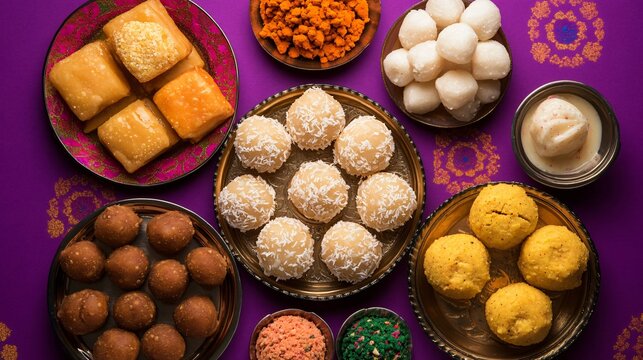South Asian cuisine is renowned for its vibrant flavors, diverse spices, and a rich cultural heritage. One of the most delightful aspects of this culinary tradition is its sweets—mouthwatering desserts that vary in ingredients, preparation, and taste across different countries and regions. From the subcontinent’s busy streets to festive celebrations, South Asian sweets are an integral part of daily life, with their indulgent flavors and intricate textures capturing the hearts of all who try them.
A Rich History of South Asian Sweets
The history of South Asian sweets stretches back thousands of years, with influences from Persian, Mughal, and indigenous culinary traditions. The Mughals, in particular, played a significant role in shaping the dessert culture in the region by introducing sugar, milk-based sweets, and techniques like syrup soaking and deep-frying. As a result, many traditional South Asian sweets are characterized by their use of rich ingredients like ghee (clarified butter), milk, sugar, cardamom, saffron, and nuts. These ingredients were not only symbolic of wealth but also believed to have medicinal properties.
Popular South Asian Sweets
- Gulab Jamun
Gulab Jamun is perhaps the most iconic South Asian sweet, loved by people of all ages. These soft, round dumplings are made from a mixture of milk solids (khoya) and flour, deep-fried until golden, and then soaked in a fragrant sugar syrup flavored with rose water, saffron, and cardamom. The result is a warm, melt-in-your-mouth treat that is especially popular during festivals like Diwali, Eid, and weddings. - Jalebi
Jalebi is a popular street food and dessert across India, Pakistan, and Bangladesh. These crispy, coil-shaped fritters are made from a batter of flour and yogurt, deep-fried, and then soaked in sweet syrup. Jalebi is known for its bright orange color and its combination of crunchy and syrupy textures, making it a beloved treat during celebrations or rainy days. - Rasgulla
Rasgulla, originating from Bengal, is a soft, spongy dessert made from chhena (Indian cottage cheese) and soaked in sugar syrup. The round, delicate dumplings are light and refreshing, with a subtly sweet taste that pairs beautifully with the warm syrup they are soaked in. Rasgulla is often served chilled and is a favorite during festivals like Durga Puja and Diwali. - Barfi
Barfi is a fudge-like sweet that comes in a variety of flavors, such as milk, coconut, and pistachio. The base of barfi is usually made from condensed milk, sugar, and ghee, which are cooked together until the mixture thickens and sets into a dense, sweet block. Barfi is typically garnished with nuts, saffron, or edible silver leaf (vark), making it a luxurious treat for special occasions. - Kheer
Kheer is a creamy rice pudding, made by simmering rice, milk, and sugar together, and flavored with cardamom, saffron, and sometimes raisins or chopped nuts. It’s a comforting dessert often served cold, though it can also be enjoyed warm. Kheer is a classic dessert at weddings, religious ceremonies, and other important celebrations in countries like India and Pakistan. - Ladoo
Ladoo is a sweet, round ball often made from flour (like chickpea or semolina), sugar, ghee, and nuts. These bite-sized treats come in many varieties, such as besan ladoo (made from chickpea flour) and motichoor ladoo (made from tiny fried pearls of flour). Ladoos are commonly served during festivals and weddings, symbolizing prosperity and good fortune.
Significance of South Asian Sweets
In South Asian cultures, sweets are more than just food—they are an expression of hospitality, celebration, and tradition. During religious festivals like Diwali, Eid, and Holi, families prepare a variety of sweets to offer to guests or as offerings to gods. Sharing sweets signifies goodwill and joy, and many people believe that consuming sweets helps strengthen relationships and fosters a sense of community.
Additionally, sweets hold symbolic importance in many South Asian cultures. For example, the sweetness of a dessert is often thought to bring prosperity, happiness, and good luck in the year ahead.
Conclusion
South Asian sweets are a delightful reflection of the region’s cultural richness and diverse culinary practices. Whether it’s the indulgent richness of gulab jamun, the crispy sweetness of jalebi, or the delicate sponginess of rasgulla, these desserts offer a sensory experience that captures the essence of South Asia’s vibrant food traditions. Each sweet has its own unique preparation method, flavor profile, and cultural significance, making South Asian desserts an essential part of both daily life and festive occasions. For anyone with a sweet tooth, indulging in South Asian sweets is an experience not to be missed.




